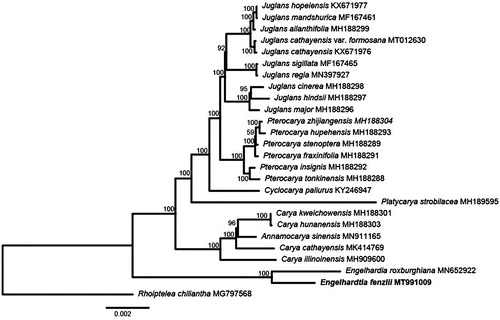Abstract
In this study, we successfully assembled and analyzed the chloroplast genome of Engelhardtia fenzlii. The chloroplast genome of E. fenzlii was very similar to those of other Juglandaceae species. The E. fenzlii chloroplast genome is 161,713 bp in length and displays the typical quadripartite structure, which consists of a pair of IR regions (26,016 bp) separated by an LSC region (90,478 bp) and an SSC region (19,203 bp). The chloroplast genome of E. fenzlii contained a total of 112 unique genes, including 78 protein-coding genes, 30 tRNAs, and 4 rRNAs. Phylogenetic analysis based on the complete chloroplast genomes showed that Engelhardtia formed a monophyletic clade and E. fenzlii was sister to E. roxburghiana.
Engelhardia Leschen. ex Blume is a genus of deciduous or evergreen trees in the walnut family (Juglandaceae) and used to be traditional medicines and health tea. Engelhardtia fenzlii is an evergreen tree species that grows at an altitude of 400 to 1000 m in south China, and traditionally used in papermaking. The chloroplast genomes are widely used in research on comparative genomics, plant system development, and phylogeny at different taxonomic ranks (Dong et al. Citation2018, Citation2020). In this study, we sequenced the complete chloroplast genome of E. fenzlii using Illumina Hiseq X ten platform. Our objective was to provide information for the systematic evolution studies of Juglandaceae, with special interest in the positioning of E. fenzlii in plant systematics and evolution.
Fresh and young leaves of E. fenzlii were collected from Gannan Arboretum, Jiangxi, China (25°51′10″∼114°22′25″) for DNA extraction. Voucher specimen was deposited at the herbarium of Jiangxi Agricultural University with the specimen voucher number of LM850486. Total genomic DNA was isolated using the Mag-MK Plant Genomic DNA extraction kit (Sangon Biotech, Shanghai, China) for constructing a shotgun library and sequencing on an Illumina Hiseq X ten platform. Low-quality reads and adapters were filtered from the raw data by using Trimmomatic (Bolger et al. Citation2014). The chloroplast genome was assembled with GetOrganelle (Jin et al. Citation2019). Plastomes were annotated with Plann (Huang and Cronk Citation2015) using Juglans regia (Dong et al. Citation2017) as reference. The annotated chloroplast genome has been deposited into GenBank with the accession number of MT991009.
The E. fenzlii chloroplast genome structure was similar to those of other Juglandaceae species (Dong et al. Citation2017). The whole chloroplast genome of E. fenzlii is 161,713 bp in length and displays the typical quadripartite structure, which consists of a pair of IR regions (26,016 bp) separated by an LSC region (90,478 bp) and an SSC region (19,203 bp). The E. fenzlii chloroplast genome possessed 112 unique genes, including 78 protein-coding, 30 tRNA, and 4 rRNA genes. GC content is 35.9%. Introns occur in 19 genes, with 17 of them having one intron while two genes (clpP and ycf3) have two introns. In rps12, a trans-splicing event was observed, with the 5′ end located in the LSC region and the duplicated 3′ end in the IR region. The trnK-UUU gene harbors the largest intron, which contains the matK gene.
To examine the phylogenetic position of E. fenzlii, Maximum Likelihood (ML) method of phylogenetic analysis was performed based on whole chloroplast genomes from 26 Juglandaceae species. The chloroplast genome sequences were aligned using MAFFT v7 (Katoh and Standley Citation2013). Ambiguous alignment regions were trimmed by Gblocks 0.91 b (Castresana Citation2002). The ML analyses were conducted using RAxML 8.0 (Stamatakis Citation2014). For ML analysis, the best-fit model, general time reversible (GTR)+G was used as suggested with 1,000 bootstrap replicates.
The monophyly of Juglandaceae was strongly supported based on the available whole complete chloroplast genome dataset. All the genera except Annamocarya in Juglandaceae were fully supported as monophyletic (bs = 100). The tribe Juglandeae was well supported, consisting of Cyclocarya, Juglans and Pterocarya and was sister to Platycarya. E. fenzlii was sister to E. roxburghiana and formed a monophyletic clade. In summary, this study will be helpful for further research on the molecular evolution and speciation of Engelhardtia ().
Disclosure statement
No potential conflict of interest was reported by the author(s).
Data availability statement
The chloroplast genome sequence of the E. fenzlii was submitted to GenBank of NCBI. The accession number from GenBank is MT991009 (https://www.ncbi.nlm.nih.gov/nuccore/MT991009). The raw data has been deposited in SRA under accession number SRR12628799 (https://www.ncbi.nlm.nih.gov/sra/?term=SRR12628799).
Additional information
Funding
References
- Bolger AM, Lohse M, Usadel B. 2014. Trimmomatic: a flexible trimmer for Illumina sequence data. Bioinformatics. 30(15):2114–2120.
- Castresana J. 2002. GBLOCKS: selection of conserved blocks from multiple alignments for their use in phylogenetic analysis. Mol Biol Evol. 17(4):540–552.
- Dong W, Xu C, Li W, Xie X, Lu Y, Liu Y, Jin X, Suo Z. 2017. Phylogenetic resolution in Juglans based on complete chloroplast genomes and nuclear DNA sequences. Front Plant Sci. 8:1148.
- Dong W, Xu C, Wen J, Zhou S. 2020. Evolutionary directions of single nucleotide substitutions and structural mutations in the chloroplast genomes of the family Calycanthaceae. BMC Evol Biol. 20(1):96.
- Dong W, Xu C, Wu P, Cheng T, Yu J, Zhou S, Hong D-Y. 2018. Resolving the systematic positions of enigmatic taxa: manipulating the chloroplast genome data of Saxifragales. Mol Phylogenet Evol. 126:321–330.
- Huang DI, Cronk QCB. 2015. Plann: a command-line application for annotating plastome sequences. Appl Plant Sci. 3(8):1500026.
- Jin J-J, Yu W-B, Yang J-B, et al. 2019. GetOrganelle: a fast and versatile toolkit for accurate de novo assembly of organelle genomes. bioRxiv, 256479.
- Katoh K, Standley DM. 2013. MAFFT multiple sequence alignment software version 7: improvements in performance and usability. Mol Biol Evol. 30(4):772–780.
- Stamatakis A. 2014. RAxML version 8: a tool for phylogenetic analysis and post-analysis of large phylogenies. Bioinformatics. 30(9):1312–1313.

